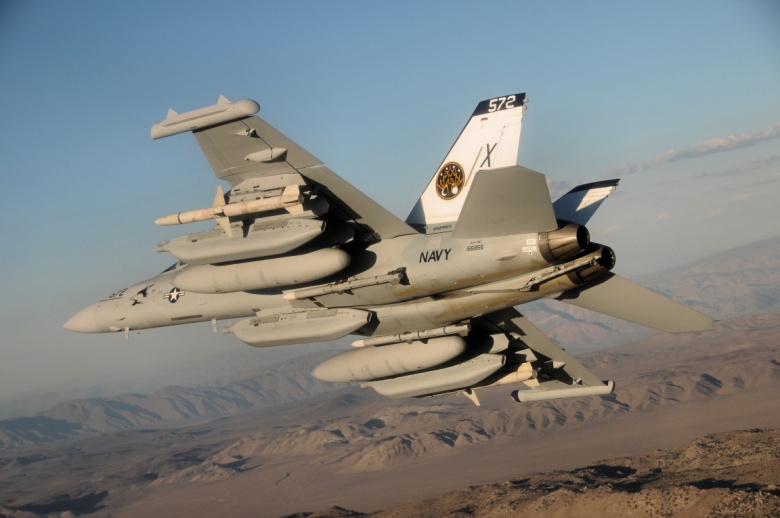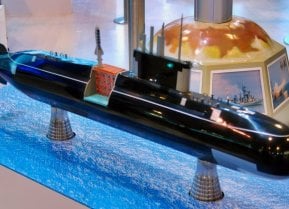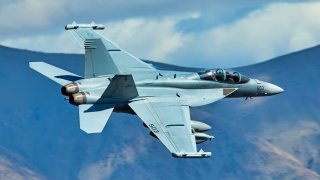EA-18G Growler: The U.S. Navy's Most Important Plane
Since 2009, the EA-18G Growler has been the U.S. Navy’s premier carrier-based electronic warfare aircraft. The Growler’s development began in 2001.
At a glance, the Boeing EA-18G Growler looks just like the F/A-18 Super Hornet.
The fuselage is familiar. The canopy is familiar. The flight surfaces are familiar. But upon closer inspection, the Growler reveals itself as a distinct aircraft – clearly formed from the Super Hornet, yet not quite the same. And while the Super Hornet is a multirole fighter, capable of conducting a wide array of mission profiles, the Growler is more specialized – as reflected in the airframe’s design tweaks.
The EA-18G Growler Forges Its Own Identity
The Growler is of course directly descended from the Super Hornet; the two relatives share 90 percent commonality.
The modified Growler shares similar flight performance characteristics with the Super Hornet, which is functional and intentional, allowing the Growler to escort Super Hornets during all phases of an attack mission.
The EA-18G Growler was redesigned slightly, however, to allow the jet more stable flight, which in turn would allow for more effective electronic warfare countermeasures. To this end, Boeing adjusted the Growler’s leading-edge fairings and wing fold hinge fairings.
Boeing also added wing fences and aileron “tripper strips.” And for the Growler, the Super Hornet’s cannon was removed, leaving the Growler cannonless. The space where the cannon would have gone is now used to house electronic attack equipment. More electronic equipment is housed on the wingtips. If needed, additional electronic equipment can be mounted to the nine weapons pylons. The weapon pylons can also be used to carry, intuitively, weapons – giving the Growler the potential to deliver plenty of firepower, despite being specially designed for electronic warfare.
Developed Post-9/11
Since 2009, the EA-18G Growler has been the U.S. Navy’s premier carrier-based electronic warfare aircraft. The Growler’s development began in 2001. In November, shortly after the 9/11 terrorist attacks, Boeing tested a F/A-18 fitted with an ALQ-99 electronic warfare system, the specially outfitted Hornet was designated the EA-18g Airborne Electronic Attack (AEA) concept aircraft.
The ALQ-99 is an integrated jamming system. Designed by EDO Corporation, the ALQ-99 includes receiver equipment and antennas that mount in a fin-tip pod, plus jamming transmitters and exciter equipment that is held under an aircraft’s wings, in pods.
The system is very clever; it can intercept, process, and jam radio signals. Then, the system can detect, identify, and direction-find those radio signals, which results in signals intelligence (SIGINT).
Capable of providing 6.8 kilowatts of power, the ALQ-99 relies on its own ram air turbine for power. The AlQ-99 has not always worked reliably and the Navy is researching a potential upgrade. Regardless, the ALQ-99 is not the only bit of electronic warfare tech onboard the Growler.
The Growler Packs Electronic Capabilities
The ALQ-218 Electronic Warfare Warning Setwideband receiver is mounted on the Growler’s wingtip. Also used on the F-15, the ALQ-128 is an electronic countermeasure. A Magnavox product, the system allows for automatic countermeasures that provide information through radar warning suites to facilitate the active jamming of enemy radar. Recently ordered Growlers have also been outfitted with Raytheon’s Forward-looking infrared (FLIR) cameras, which use a thermographic camera to sense infrared radiation.

The EA-18G Growler made its combat debut in 2011, enforcing a UN no-fly zone over Libya during Operation Odyssey Dawn. To date, the Growler does not have the extensive combat experience of its ancestor, the F/A-18. Currently, eighteen Navy squadrons proudly fly the Navy’s 172 Growlers.
About the Author
Harrison Kass is a defense writer with over 1,000 published articles. An attorney, pilot, guitarist, and minor pro hockey player, he joined the US Air Force as a Pilot Trainee but was medically discharged. Harrison has degrees from Lake Forest College, the University of Oregon School of Law, and New York University’s Graduate School of Arts & Sciences. He lives in Oregon and regularly listens to Dokken.
Main image is from Shutterstock. The text image is Creative Commons.


